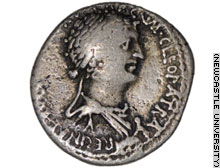Ancient Coin Shows Cleopatra Was No Beauty
Ancient coin shows Cleopatra was no beauty
From:
Feb 15, 2007
LONDON, England (CNN) -- Antony and Cleopatra -- one of history's most romantic couples -- were not the great beauties that Hollywood would have us believe, according to British academics.
A study of a 2,000-year-old silver coin found the Egyptian queen, famously portrayed by a sultry Elizabeth Taylor, had a shallow forehead, pointed chin, thin lips and sharp nose.
On the other side, her Roman lover, played in the 1963 movie by Richard Burton, Taylor's husband at the time, had bulging eyes, a hook nose and a thick neck.
History has depicted Cleopatra as a great beauty, befitting a woman who as Queen of Egypt seduced Julius Caesar, and then his rival Mark Antony.
But the coin, which goes on show on Wednesday at Newcastle University for Valentine's Day, after years lying in a bank, is much less flattering about both famous faces.
The 32BC artifact was in a collection belonging to the Society of Antiquaries of Newcastle upon Tyne, which is being researched in preparation for the opening of the new Great North Museum.
Clare Pickersgill, the university's assistant director of archaeological museums, said: "The popular image we have of Cleopatra is that of a beautiful queen who was adored by Roman politicians and generals.
Relationship romanticized
"The relationship between Mark Antony and Cleopatra has long been romanticized by writers, artists and film-makers.
"Shakespeare wrote his tragedy Antony and Cleopatra in 1608, while the Orientalist artists of the 19th century and the modern Hollywood depictions, such as that of Elizabeth Taylor and Richard Burton in the 1963 film, have added to the idea that Cleopatra was a great beauty.
"Recent research would seem to disagree with this portrayal, however."
The university's director of archaeological museums, Lindsay Allason-Jones, said: "The image on the coin is far from being that of Elizabeth Taylor and Richard Burton.
"Roman writers tell us that Cleopatra was intelligent and charismatic, and that she had a seductive voice but, tellingly, they do not mention her beauty.
"The image of Cleopatra as a beautiful seductress is a more recent image."
The silver denarius coin would have been issued by the mint of Mark Antony.
On one side is the head of Mark Antony, bearing the caption "Antoni Armenia devicta" meaning "For Antony, Armenia having been vanquished."
Cleopatra appears on the reverse of the coin with the inscription "Cleopatra Reginae regum filiorumque regum," meaning "For Cleopatra, queen of kings and of the children of kings," or possibly "Queen of kings and of her children who are kings."
Experts say the coin, on display in Newcastle University's Shefton Museum, is not particularly rare but is very collectable. The collection has been owned by the Society of Antiquaries of Newcastle upon Tyne since the 1920s.



